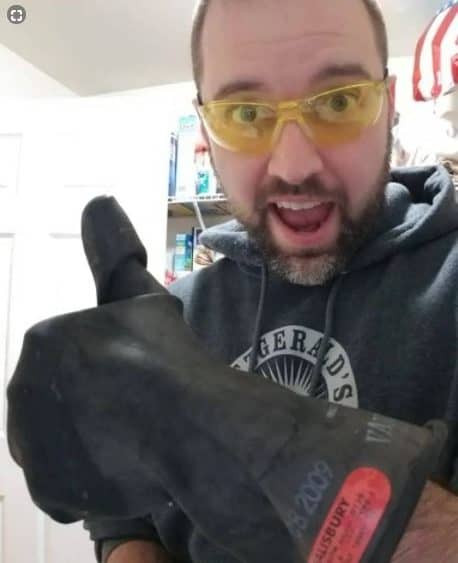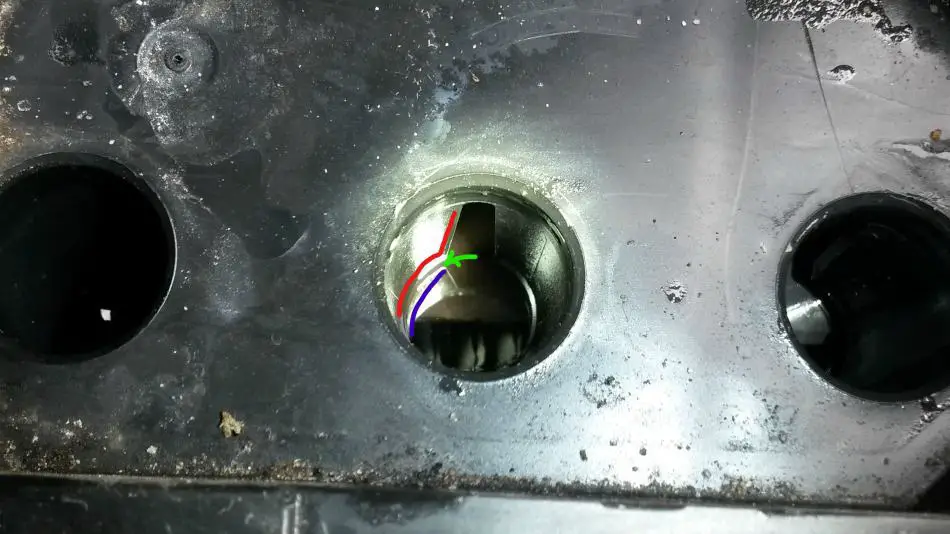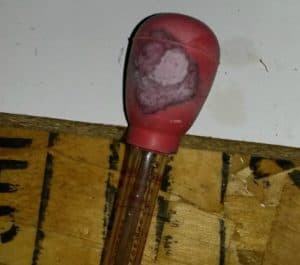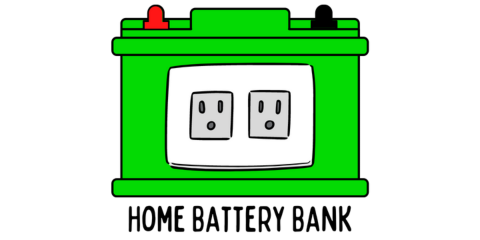Buying a lead-acid battery isn’t the most exciting thing in the world, and if you want one for a particular purpose it can be a little stressful finding the right one to meet your needs. Once the purchase is done, most people install it and relax – never to think about the battery again.
Don’t fall into this trap! Unless you have a sealed/maintenance-free lead-acid battery like a Gel Cell or AGM, your flooded lead-acid battery needs a little TLC from time to time to check the water and electrolyte solution.
The amount of water (electrolyte) in a wet-cell battery should be 1/8″-1/4” below the bottom of the fill tubes that extend down from the opening of each battery. Only distilled water should be used to fill low water levels.
However, in a 10-part step-by-step process, I’ll go over how to prepare for this task, how often the water should be checked, and how to properly check and maintain the battery with some beginner mistakes to watch out for scattered throughout.
Step 1.
Wear clothes that you do not care about getting holes in (long sleeve to cover your skin), wear eye protection and rubber gloves. I also have a small bucket of water nearby as an emergency if I have to dunk anything in it to dilute the acid before heading over to the sink.
- We’re dealing with battery (sulfuric) acid here. It will eat your clothes if there is a splash and it will burn your skin. Don’t take any chances!

Step 2:
Unplug anything from the wall that is attached to your battery with alligator clips! Don’t worry about the cables that are hooked up to the battery in your car if they are in good condition. Cables that are held down securely by a nut on the threaded battery post are fine. Just make sure any active chargers are turned off.
- The area where hydrogen gas builds up the most is right below the cap. Hydrogen gas is extremely flammable and explosive. The last thing we want is for there to be an excess of hydrogen gas and have you bump an alligator clip from a terminal and have it create a spark. Bad things happen to good people! Don’t let it happen to you!
Step 3:
Clean the top of the battery of all dirt and debris.
- A disposable rag with normal water or some window cleaner will be just fine for this task. Wipe up everything that you can see. Dry all surfaces that you got wet.
- You’re about to expose the cells of the battery and don’t want dirt or anything mixing with the acid.
- Especially with my car battery, which accumulates a lot of dirt and dead bugs on top of it, I use a shop-vac to vacuum any crevices around the caps for the battery cells.
Step 4:
Access the cells of the battery by removing the rectangular plates on top of the car or marine batteries, or by twisting the battery cap configuration on a golf cart battery.
- You’ll need a flat-head screwdriver or similar tool to pry the plate up on the car or marine battery. Work your way gently around the edge.
- If there was excessive dirt or debris, I recommend carefully prying up only a small amount (1/16 of an inch) on all sides and quickly hitting it again with the vacuum along the edges of the plate to remove anything that was pinned in there before.
- Do not let the tool you were using touch both terminals of the battery. Again, the hydrogen gas is not exposed and we do not need a spark at this time.
Step 5:
Visually inspect the water levels in each cell with a flashlight.

- The water levels should be equal, and ideally about ⅛” below the bottom of the fill tubes that extend down from the opening of each of the battery cells.
- If my car battery has been running just fine and not giving me issues and the water levels look good, then this is about as far as I go with the process. I just put the cap-plate back on and move on with life.
- If the cells are uneven, or really low we will move on to the next step.
Step 6:
Decide if distilled water needs to be added (See below)
- Only add water if the battery is already fully charged.
- If the battery is not fully charged but the lead plates are exposed down in the cell, you’ll want to add only enough water to cover the plates. Charge the battery (manually or by driving it for a while) and then add the appropriate amount of water. Recharge again afterward.
Step 7:
Add distilled water

- I find that the easiest and safest way to do this is with a syringe. Having kids, I usually get one for free with any medication that I pick up from the local pharmacy. Just suck up some distilled water, and gently add as much as you need. Unless you’re reckless it eliminates splashing acid all over everything, overfilling by just pouring the jug, and always allows accurate results every time!
- Add enough to be 1/8″ below the split-ring fill tube that extends partially down from the opening of the cell. The max that the water should be is where it is just touching the edge of the fill tube.
- We are using distilled water only! Tap water, well water, and all other water sources have mineral deposits, chemicals, and impurities which, over time, will reduce the capacity and lifespan of your battery. This is also why it’s important to clean the top of the battery properly so that nothing enters into the exposed cells!
Step 8:
Replace the cap plate on the car or marine battery, or twist back on the battery cap configuration on a golf cart battery.
Step 9:
Wipe up any spills or drops of battery acid with a damp paper towel or disposable rag. Wipe dry. Dilute first in that small bucket of water and then dispose of the rags.
Step 10:
Plug your charger back in (if it’s not connected to your car).
- If you’re checking a car battery, don’t worry too much about driving it immediately to charge the battery if the water was just a little low and needed to be topped off. If your battery has been experiencing some issues, or if you just added water because the plates were exposed, it’s a good idea to start your car up and let it run for a while. Taking it for a couple miles on the road while not running the air conditioning should suffice.
- A good battery charger is always a great idea if you have a battery that has been experiencing some problems.
- If you did have to cover the plates because they were exposed, just know that your battery has already experienced permanent damage. Make sure to keep an eye on the water level every couple days initially to make sure you don’t have a cracked cell that is leaking.
Importance of Specific Gravity
Just remember that the battery acid/electrolyte is composed basically of 75% distilled water and 25% sulfuric acid. When the battery heats up or goes through a thorough charging, it will naturally lose some water due to evaporation. That’s why we add the water back to the battery. We do not add acid back to a battery!
Simply adding water back to where it should be is a great way to keep things maintained, but water levels only show you one part of the equation. We also need to check the “specific gravity” from time to time to make sure our battery is healthy.
Specific gravity is basically the density of the electrolyte within each cell, or in other words, how watered down the cell is between the sulfuric acid and water ratios at a given point in time. This changes depending on how charged the battery is when you measure it.
The sulfuric acid changes densities in each cell depending on the charge of the battery. The more charged it is, the denser the sulfuric acid is within each cell. The more a battery has been used without being charged, the less dense the sulfuric acid is. This is due to the fact that it has now bonded with the lead plates and changed form. Recharging the battery releases it once again to the electrolyte mix in the cell.
To check the specific gravity, you need a hydrometer. Most people can probably get away with an inexpensive one like the one seen here on Amazon.
Dip the tube down into the electrolyte, gently squeeze the bulb a few times to stir mix the electrolyte. Suck in a large amount of electrolyte until it reaches the fill line, and make sure air bubbles are not present. Gently tap the hydrometer to work out any imbalances. Let it settle and you’ll get your reading. Be sure to keep the water flush with the fill line and don’t hold the hydrometer at an angle for an accurate reading!
Remember that when you are done, to rinse out the inside of your hydrometer with some distilled water by sucking some up into it a few times. I made this mistake and let my hydrometer sit around for one month without a rinse. The acid had badly damaged the bulb.

The Wrap-Up
It does seem like a tedious process to check on and maintain a battery. We take them for granted all the time. I turn the key in the car and it starts. What could go wrong?
When you think about how crucial they are though to our everyday life, it’s probably worth it to check on them a little more often. If you only do it once a year, try doing it twice a year. If you do it twice a year, strive for once a month. The more often you do it the less there is to clean and the faster the process goes.
It’s baby steps like this that will keep your battery in the proper state of charge for when you need it most. Take care of it, and it will take care of you. I hope this helped you to gain a basic understanding of battery maintenance and helps you feel more comfortable doing it yourself. If you still feel intimidated or are unsure about any step in the process, it’s a great idea to reach out to someone who can mentor you through the process!
